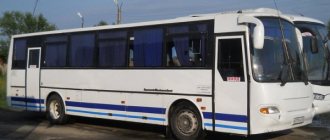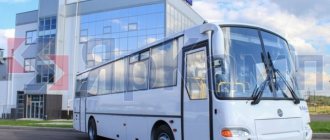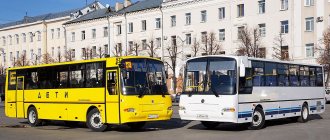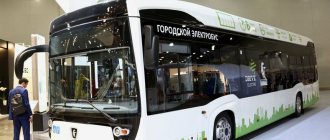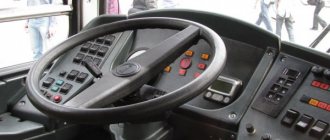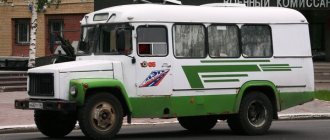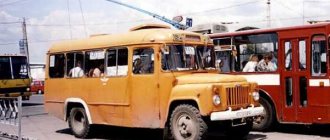City bus KAVZ-4238. Photo YarCamp
In 2006, production of various modifications of the PAZ-4238 was established at the Kurgan Bus Plant under the KAVZ-4238 “Aurora” brand. In 2010, a school bus based on the KAvZ-4238 Aurora was created and certified. The Kurgan Bus Plant became the first in Russia to develop a school bus based on GOST R 51160-98 “Buses for transporting children. Technical requirements". In 2012, the Kurgan Bus Plant developed the KAVZ-4238, which runs on compressed natural gas and is equipped with a gas engine that meets the Euro-5 environmental standard. In 2013, a prototype was manufactured and certified.
Detailed description, device
KAVZ-4238 is an extended modification of the KAVZ-4235 bus, designed to operate on suburban and intercity routes up to 500 km long.
A comfortable interior, an optimal number of seats, spacious luggage compartments (!not available for all modifications), and an economical engine make the KAVZ-4238 bus attractive for both passengers and commercial carriers.
In 2013, a gas modification of the bus was developed.
Tropical version: powerful air conditioning, enlarged side window vents, tinted windows, tires suitable for use in tropical climates, vandal-proof seats.
School version: in accordance with GOST R 51160-98 “Buses for transporting children. Technical requirements".
KAVZ-4238 school bus. Photo YarCamp
Modifications:
- KAvZ-4238-00 – long-distance, basic model
- KAvZ-4238-01 – suburban
- KAvZ-4238-02 – long-distance
- KAvZ-4238-04 – urban
- KAvZ-4238-05 – school
- KAvZ-4238-21 – suburban gas
- KAvZ-4238-41 – suburban
- KAvZ-4238-42 – long-distance
- KAvZ-4238-45 – school
- KAvZ-4238-51 – suburban
- KAvZ-4238-52 – intercity gas
- KAvZ-4238-62 – school
- KAvZ-4238-71 – suburban gas
- KAvZ-4238-72 – intercity gas
- KAvZ-4238-75 – school gas
- KAvZ-4238-81 – suburban gas
- KAvZ-4238-82 – intercity gas
- KAvZ-4238-85 – school
Modifications operating on gas are often labeled CNG.
Reference . Diesel and gas modifications have differences in some quantitative parameters and engine characteristics. At the same time, buses for different purposes have differences in interior design.
Types: school, long, elongated and more
KAVZ-3278 cargo-passenger bus with a crane-manipulator installation
KAvZ models are divided into several types:
- by appointment;
- by lenght;
- according to design features and configuration.
Purpose:
- general: urban, suburban, intercity;
- special: shift workers, all-terrain vehicles, school.
Length:
- especially small;
- small;
- average;
- large;
- especially large capacity.
Design and equipment:
- hood;
- carriage;
- rear-engine;
- central motor;
- front engine;
- low-floor;
- high-deck.
Gas, diesel and others
Cars also differ in the type of fuel used:
- models KAvZ-685, -3270 – gasoline;
- models KAvZ-4235, -4238, -4239 – diesel;
- model KAvZ-4270 – liquefied gas – methane.
The KAvZ-4270 bus runs on methane. Photo GAZ
Fuel consumption per 100 km, norm and reality
Fuel consumption depends on a number of factors, ranging from the technical condition of the engine to weather conditions. Therefore, the actual consumption is always greater than that stated in the regulatory documents.
- KAvZ – 685, -3270 (gasoline): norm – 24 l/100 km; actual – 27-30 l/100 km;
- KAvZ – 4235 (diesel fuel): norm – 23.5 l/100 km; actual – 27 l/100 km.
- KAvZ - 4238 and its modifications (diesel fuel): norm - 22-24 l/100 km; actual – 25-27 l/100 km.
- KAvZ – 4239 (diesel fuel): norm – 26 l/100 km; actual – 29 l/100 km.
- KAvZ – 4270 (methane): norm – 47 m3/100 km; actual – 47-49 m3/100 km.
Volume of the tank
Model:
- 685, -3270, -4235 – 105 liters;
- 4238 – 170 liters;
- 4239 – 200 liters;
- 4270 – 6 cylinders (665 liters of methane).
How much does it weigh, kg?
Bus KAvZ-3976. Photo Wikipedia
The weight of the most popular KAvZ models is:
- KAvZ-685: curb weight – 4080 kg; total weight – 6450 kg.
- KAvZ -3976: curb weight – 4450 kg; total weight – 5870 kg.
- KAvZ -4235: curb weight – 11040 kg; total weight – 12000 kg.
- KAvZ -4239: curb weight – 10370 kg; total weight – 16360 kg.
- KAvZ -4270: curb weight – 9740 kg; total weight – 16360 kg.
Dimensions/parameters: height, length, width
- -685: length – 6500 mm; width – 2550 mm; height – 3030 mm.
- -3976: length – 6915 mm; width – 2330 mm; height – 3030 mm.
- -4235: length – 8370 mm; width – 2500 mm; height – 2995 mm.
- -4238: length – 9610 mm; width – 2500 mm; height – 2995 mm.
- -4239: length – 10320 mm; width – 2550 mm; height – 3050.
- -4270: length – 10200 mm; width – 2500 mm; height – 3600 mm.
Tire sizes
- KAvZ-685, -3976: tires 8.25 R20.
- KAvZ-4235, -4238, -4239, -4270: tires 275/70 R22.5.
How many seats: 19, 35, 39 and more
- KAvZ-685 is equipped with 21 seats. The total number of passengers is 28 people.
- KAvZ -4235: number of seats – 31, total number of passengers – 54.
- KAvZ -4270 (methane): number of seats – 27, total number of passengers – 87.
- KAvZ -4239: number of seats – 23, total number of passengers – 93.
- KAvZ -4238/41: number of seats – 39, total number of passengers – 39.
- KAvZ -4238/42: number of seats – 35, total number of passengers 48.
Seating location
There is no uniform layout of seats. The main requirement is the safety of passengers during the trip. Therefore, the seat layout may differ significantly for KAvZ models:
Model -4235-Aurora
Interior diagram of the KAVZ-4235 Aurora bus. Photo YarCamp
Model -4238
Scheme of the interior of the KAVZ-4238 bus. Photo YarCamp
Carriage and hood layout
Based on their layout, KAvZ buses are divided into two types: bonnet and carriage.
The hood type of body is also called 2-volume. With this type, the passenger compartment is separated from the engine. This type includes models KAvZ -685, -3976.
The carriage type is called single-volume, since the power unit is located in the engine compartment, located at the rear of the bus and is integral with the passenger compartment. This type of layout is the most optimal, because 90% of the usable area is reserved for passengers. Used on all modern models of KAVZ buses.
Low and high deck
Low-floor buses are widely used on city routes. Convenient and safe boarding and disembarking of passengers, especially children and the elderly. For the category of citizens with disabilities, lowering ramps are provided.
The “low-floor” ones include KAvZ -4239 and -4270.
KAvZ-4270 – middle class bus (90 (28+1) seats). Photo RusbusinessAuto
High-deck buses are distinguished by the presence of compartments for various purposes under the passenger compartment. Used on intercity and tourist routes. This type includes models KAvZ -4235, -4238 and their modifications.
Basic information, characteristics
Interior of the intercity bus KAvZ-4238 Aurora. Photo Skat-Auto
Manufacturer/manufacturer where the equipment is produced/manufactured. "KAVZ" (formerly the Kurgan Bus Plant named after the 60th anniversary of the USSR (KAvZ)) is located in the city of Kurgan. LLC "KAvZ" is a subsidiary of OJSC "GAZ" (100% share in the authorized capital). The functions of the sole executive body of this company are performed by the management organization - LLC "UK Group GAZ".
Purpose. Suburban, intercity, city, school.
Class. Average.
Body type. Carrier, carriage layout.
Body resource. 8 years.
Criteria for classifying vehicles of the middle group
The industry provides a wide range of passenger transport. For a better understanding of the features and parameters of each type of equipment, as well as to facilitate the selection of a model with optimal characteristics, there is a classification. The division is performed according to several properties.
Capacity: small, medium and others, dimensions, length
This parameter is calculated in the number of seats and the number of nominal/total capacity. The number of passenger seats directly affects the dimensions (or, more precisely, the length) of the bus body.
Low-floor, middle-class bus for urban transportation LiAZ-4292. Photo GAZ
The capacity and therefore the size of the vehicles allows all passenger transport to be divided into five separate groups. Buses of each category have certain minimum and maximum values. And if the dimensions for buses for different purposes are the same, then the capacity may differ.
- Particularly small (length no more than 6 meters) and small (6-8) have excellent maneuverability and mobility, therefore they are actively used on city routes.
- Medium (8-10) buses are the most popular class, due to their versatility; the vehicles are used on urban and suburban, intercity and tourist routes. In addition, the equipment provides a good level of comfort and capacity (up to 39 people), while maintaining good maneuverability and acceptable driving parameters.
KAvZ-4270 – middle class bus (90 (28+1) seats). Photo RusbusinessAuto
Large (10-12) and extra large (12-18) models are integral elements of large cities, which are characterized by significant passenger traffic.
Purpose: urban and others
Depending on the purpose, passenger transport of general and special use is distinguished. The equipment of the first category includes urban, suburban, intercity (sleeping models are a popular type), and tourist. These types of equipment can be converted into special vehicles, the list of which includes:
- cargo-passenger;
- all-terrain vehicles;
- shift workers;
- school;
School bus PAZ-4234-70 middle class with a capacity of 29 people. Photo YarCamp
- ritual;
- medical;
- excursion;
- apron/airfield;
- for celebrations, parties;
- for emergency services.
Other characteristics
Other characteristics are also used for classification, according to which the following types of buses are distinguished:
- layout: carriage and hood type buses;
- floor arrangement: low-floor and high-floor;
- number of levels: one-, one-and-a-half and two-story;
Intercity single high-floor bus KAvZ-4238 Aurora. Photo Author
- location of the power unit; rear-, central- and front-engine;
- number of passenger sections: single and articulated.
Basic characteristics
Body dimensions, mm. Length/Width/Height – 10030 / 2500 /3060 (3110 with air conditioning).
Ceiling height in the cabin, mm. 1980.
Number and dimensions of doors. 2/650.
Total number of seats, including landing seats. 40 (35+1), 44 (39+1).
The type of seats depends on the purpose of the bus. The intercity cabin is equipped with soft, adjustable seats, with armrests, on a podium, and with seat belts. City, suburban and school - plastic seats with soft inserts.
Bus KAVZ-4238-02
Photo bus KAVZ-4238-02
Manufacturer:
Kurgan Bus Plant LLC 640008, Russia, Kurgan, st. Avtozavodskaya. 5
Technical characteristics of the KAVZ-4238-02 bus
| Passenger capacity, persons | 40 |
| Gross weight of the bus, kg | 12250 |
| Engine power, hp | 207 |
| Wheel formula | 4x2 |
| Overall dimensions, mm | 10000/ 2500/ 3085 |
| Base, mm | 4900 |
| Ceiling height in the cabin, mm | 1980 |
| Number of doors | 2 |
| Width of doorways, mm | 680 |
| Total number of seats (including landing seats) | 40 / 35+1 |
| Curb weight, kg | 8435 |
| Fuel tank capacity, l | 170 |
| Engine model | Cummins, 6 ISBe 210, EURO-3 |
| Max. speed, km/h | 105 |
| Volume of luggage compartments, cubic meters | 3,4 |
| Purpose | For intercity and suburban transportation |
| Sale, repair and spare parts for Bus KAVZ-4238-02 KAVZ-4238-02 | You can buy a KAVZ-4238-02 bus from the Kurgan Bus Plant company, which produces and sells them. |
www.kommashpro.ru
Specifications
Intercity bus KAvZ-4238 Aurora. Photo Author
Fuel type. Diesel/gas
Fuel tank capacity. 170 / 615 or 739 (5 cylinders).
Curb and technically permissible weight, kg. 8320…8685 or 8435…8800/12600 / 8814…8929 or 9350…9465/12600.
Load on front/rear axle based on technically permissible weight, kg. 4290/8310.
Minimum turning radius, m. 11.
Front approach angle/rear departure angle, degrees. It varies for different modifications, it is recommended to check when purchasing.
Steering gear. ShVGU-430 or ZF-8095 integral type.
Brake system. Working: pneumatic, dual-circuit, with division into circuits along the axes, drum brakes on all wheels, ABS. Parking: rear wheel brakes. The drive is mechanical from spring energy accumulators with pneumatic control. Spare: performs one of the circuits of the service brake system. Auxiliary: engine brake.
KAVZ-4238
Technical characteristics of KAVZ-4238 buses | |
| Bus model | KAVZ-4238 "Aurora" |
| Bus class | Average |
| Purpose | Suburban/Intercity |
| Wheel formula | 4 x 2 |
| Body life, years | 10 |
| Length Width Height | 9610 / 2500 / 2995 |
| Base, mm. | 4840 |
| Ceiling height in the cabin, mm. | 1980 |
| Floor height, mm | 900 |
| Number/width of doors, mm. | 2 / front - 830, rear - 770 |
| Total number of seats (including landing seats) | 37 (35) |
| Load on front/rear axle, kg | 2750 / 5070 |
| Front approach angle/rear departure angle, degrees | 10 / 10 |
| Front/rear overhangs, mm. | 2180 / 2590 |
| Curb weight, total, kg. | 7820 / 10470 |
| Bridge | RZAA |
| Steering gear | MAZ-64229, power steering |
| Brake system | Working : pneumatic double-circuit drive with division into circuits along the axes, with ABS, drum brakes on all wheels |
| Ventilation | natural through vents and ventilation hatches in the roof |
| Fuel tank capacity, l | 105 |
| Heating system | Liquid from the engine cooling system and an independent heater, has three heaters with electric ventilation blowing air through the radiators |
Power unit | |
| Engine | Cummins B 180 20 |
| Number of cylinders | 6 |
| Cylinder arrangement | in-line |
| Environmental safety standards | EURO 2 |
| Working volume (l.) | 5,9 |
| Rated power kW (hp) at crankshaft speed rpm | 132 (180) 2500 |
| Maximum torque N.m. at crankshaft rotation speed rpm | 650 1500 |
| Location | rear longitudinal |
| Maximum speed km/h | 110 |
| checkpoint | Kamaz-141, mechanical, 5-speed, synchronized, electro-pneumatic gearbox control |
| KAVZ buses | |
ooo-kavz.narod.ru
additional characteristics
Ventilation. Natural, through the roof hatches and side window vents. The windshield is blown from the front heater.
Heating system. Combined, from the engine cooling system and liquid heater. 3 heaters are located in the cabin, the driver’s workplace is heated by a front heater with two air intake modes.
Luggage compartment volume, cubic meters Luggage compartments in modifications differ in design and volume. Some modifications have pass-through luggage compartments.
Luggage compartment location. In the middle lower part of the body.
Archive of KAvZ brand models
KAvZ 6851971
History of the KAvZ / KAvZ brand
The history of the Kurgan Bus Plant actually begins in 1958, when the first bus with a hood layout was produced - KAvZ 651. It was a model designed on an extended GAZ 51A truck chassis. A total of 508 units were produced in the first year of production, 1,511 in 1959, and 3,434 buses left the factory in 1960. During the first 5 years, KAvZ reaches a design capacity of 5 thousand cars per year. By 1967, the plant managed to build about 50 thousand buses. In the same year, a prototype of the service KavZ 685 was produced, based on the GAZ 53 chassis. But mass production of the model began only in 1971 after lengthy tests.
In 1983, KAvZ mastered the production of modernized buses model 685M, built on the GAZ 53-12-1040 platform. Externally, the model was almost identical to its predecessor, but since 1984, the trapezoidal radiator grille was replaced by a recognizable rectangular shape. This, in fact, became the most serious difference between the updated KAvZ 685M and the previously produced 685 model. In 1986, modernized buses were released, which received the identifier 3270. A distinctive external feature of the KAvZ 3270 is the characteristic transition of the roof in the windshield area, where the wiper mechanisms were installed, as well as an information plate with route data. In addition, the rear-view mirror brackets have undergone changes, and 2 ventilation holes have appeared on the roof. In 1989, the plant in Kurgan began producing a new model 3976.
In the 1990s, production began to decline at KavZ. After bankruptcy in 2003, the plant was purchased by the RusPromAvto holding, which in 2005 became part of the GAZ group of companies. The history of KAvZ buses, which used the cargo chassis of the Gorky Automobile Plant, ended in 2007 with the removal of model 3976 from the assembly line. As of 2009, the modern KAvZ model range consists of rear-engine mid-size buses of the Aurora family for suburban and interdistrict traffic, radically different in design from their predecessors. In 2014, the plant started production of updated environmentally friendly models KAVZ-4238 CNG and KAVZ-4270 CNG, powered by gas. Currently, the company produces buses for use on urban, suburban and intercity routes. KAvZ became the first plant to develop a school bus that meets all state standards.
Engine/powertrain characteristics
| Options | CUMMINS 6 ISBE4 210V | CUMMINS 6 BGE5 230 (CNG) |
| Type | Diesel engine | Gas engine |
| Number and arrangement of cylinders | 6R, vertical | 6R, vertical |
| Environmental safety standards | Euro 5 | Euro 5 |
| Working volume, l | 6,7 | 5,9 |
| Engine power, kW (hp)/min | 145 at 2300 min-1 | 168.8 at 2,800 min-1 |
| Max. torque, Nm/min | 750 at 1100…1800 min-1 | 678.3 at 1,800 min-1 |
| Engine location | Rear, longitudinal | Rear, longitudinal |
| checkpoint | Manual transmission: ZF 6 S 1010 BO, 6 speed. or Eaton, FSO-5206 | Manual transmission: ZF 6 S 1010 BO, 6 speed. or Eaton, FSO-5206 |
| Maximum speed, km/h | 100 | 100 |
| Bus warranty | 2 years or 100 thousand km | 2 years or 100 thousand km |
First generation 1989–2004
As mentioned earlier, over 18 years of assembly, some modernization of the KavZ-3976 vehicle was carried out. Its technical characteristics are not very impressive. In order to reduce costs, the manufacturer chose to install, let’s say, not the latest technologies on the bus. However, it cannot be called completely unsuitable for use. He coped with the tasks assigned quite well.
In 1989, the bus was equipped with a domestic ZMZ-513 engine. This model was considered primitive even at that time. It is a simple V-shaped carburetor-type device with 8 valves, which are located at right angles. The maximum power threshold that this power unit could produce stops at 125 hp. With. The speed limit did not exceed 90 km/h. Over the years of operation, the engine has proven itself to be reliable under all conditions.
Additional options
Reliability indicators:
- Service interval - 12 thousand km
- Ease of maintenance
- Possibility of installing automatic transmission
Performance indicators:
- Favorable cost of ownership
- Optimal passenger capacity
- Reduced operating costs due to low gas fuel costs
- High level of comfort for driver and passengers
- Affordable price
Comfort options:
- Audio/video system
- Various passenger seat options
- Electronic route indicators
- Metallic body paint
- Insulated clear glass unit.
- Tinted double-glazed window (only for the Insulated modification).
- Exterior (new front mask with Hella lighting technology).
- DVD, CD player with 2 LCD monitors 15″ + 6 speakers + antenna.
- DVD, CD player with one 19″ LCD monitor + 6 speakers + antenna.
- VGGU.
- NGGU loudspeaking device.
- CD radio + 4 speakers + antenna.
- Roof fan (blowing the driver's workplace or passenger compartment).
- Electronic route indicator Iskra 4235/4238 (three displays).
- Tires MICHELIN or MATADOR 275/70 R22.5.
- Air conditioning with individual airflow.
- Luggage racks.
- Passenger seats with a device for moving to the center, with a net and a table.
- Curtains on the salon windows.
- Plastic upholstery.
- Interior upholstery is caprovelor.
- Carpeting in the center aisle + mats on the front and rear landings + on the front steps.
- Carpeting in the luggage compartment.
- Air autonomous heater.
- Double glazing of salon windows (tinted double glazing).
- Double glazing of salon windows (clear glass).
- Single glazing is tinted, except for the windshield, driver's window and front door glass.
- Thermal insulation of heating and cooling system pipelines.
- Heating the fuel tank intake.
- Non-adjustable seats with 3-point seat belts.
- Adjustable seats with 3-point seat belts.
- Satellite navigation equipment.
- Air autonomous heater for the driver's cabin.
- Gas cylinders capacity 739 l.
- Reversing sound signal.
Security options:
- Digital tachograph
- Video surveillance system
- Fire extinguishing system
- Fog lights
Advantages and disadvantages
Purchasing the KAVZ-4238 model ensures fast and uninterrupted passenger flow, be it suburban or intercity routes. The cost of purchasing this vehicle quickly pays for itself due to its low fuel consumption and long operating time. The service life of some components reaches one million kilometers. The factory warranty period for the body assembly is eight years. Despite the length of the KAvZ-4238 base, equal to 4.9 meters, the vehicle remains quite fast and maneuverable, both in difficult urban conditions and on intercity routes, not only in summer, but also in winter.
The location of the engine of the vehicle in question is its rear part, which helped to save space that was needed to install additional seats. This intercity and commuter bus is equipped with a gearbox that is simple in operation, easy to maintain and durable in service life. The fuel tank of this car holds 170 liters of diesel fuel, thanks to which a vehicle of this model can do without intermediate refueling for a long time, which is important for intercity passenger transportation over long distances. These factors save time for people who decide to use the services of this bus. At the same time, the length of routes served by such buses increases significantly.
As an option, the KAvZ-4238 model can be equipped with cabin air conditioning, which will provide additional convenience and comfort in the cabin, no matter how long the route. According to reviews from operating organizations and numerous passengers, the bus has a comfortable passenger compartment, an ergonomic driver's workplace, good visibility, a smooth ride, excellent handling and maneuverability.
With the help of the KAVZ-4238 bus, a route length of 500 km is provided, thanks to which you can easily organize passenger transportation and accurately calculate fuel consumption and trip duration.
Among the inconveniences most often mentioned are the insufficient capacity of the luggage compartment, the not very good location of the communication electrical unit and the low power indicators of the engine for the bus when it is fully loaded.


